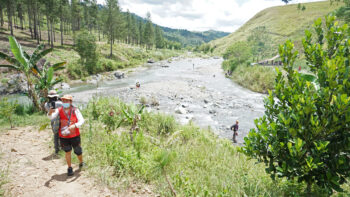
MATALAM, North Cotabato (MindaNews / 22 June) – Now, it seems, that we won over the pandemic (COVID-19), we might be thinking that we are now hassle-free. No. The impact of the more than two-year-old pandemic on the economy would be most felt now than before. Unlike the health sector where the pandemic’s effect on people and their lives is immediate, the economy takes a few breathing space before it succumbs to the disease.
At most, we are just in the midst of an asymmetrical recovery where the focus is on the twin concerns of containing the virus and at the same time trying to mitigate its effect on the economy. After we have seen the virus transmission curves flattened we begin to think that the pandemic’s effect on people and the economy are controlled. It is at this point where economic recovery becomes a relevant agenda of government.
The concept of economic recovery starts from data indicators that give us benchmarks for planning.
Here is a United Nations report that will certainly pull us from our seats:
“Already we are beginning to understand the potential socio-economic impacts of this pandemic:
- The World Bank has warned that it could push between 40 and 60 million people into extreme poverty this year, with Sub-Saharan Africa hit hardest followed by South Asia (where the Philippines is);
- The International Labor Organization expects the equivalent of 195 million jobs lost; and
- The World Food Programme projects that 135 million people are facing crisis levels of hunger or worse, while another 130 million are on the edge of starvation.”
The UN also suggested urgent socio-economic response, based on the five critical pillars: 1) Protecting health services and systems; 2) social protection and basic services; 3) protecting jobs and small and medium-sized enterprises, and the most vulnerable productive actors; 4) macroeconomic response and multilateral collaboration; and 5) social cohesion and community resilience.
The COVID pandemic has no doubt dented world economies in no small measure. This major economic slowdown has taken its toll on most countries of the world in varying degrees depending on several factors such as: proximity to and frequency of contact with China (ground zero of COVID 19), population of major urban centers, effectivity and promptness of response, and the public attitude in general.
The actual toll on the world economy or on countries of the world cannot be ascertained for now because the virus still continues to wreak havoc in some countries, and quite unfortunately, even major economies once touted to be strong and resilient like those of the US, Spain, China, United Kingdom, France, Germany, Italy, and Hong Kong were not spared.
Not to be discounted are the negative effects the pandemic has inflicted on the social and political positions of most countries. The US is even contemplating to put China to task on the suspicion that the communist country had lied or hidden significant information about the new corona virus from the beginning. Whether that was true or not is already water under the bridge. I once joked: “Well, China would not want to die alone.”
But whatever was past and present about this pandemic, the future shall have to be secured and ascertained by well-grounded plans from this time on.
This too shall pass, yes, but for how long, this is quite unpredictable for now because even the experts are backing their estimates and projections on vaccination status of most countries.
At this point, the best thing to do is to prepare and lay the ground on where and how to move around in a post-COVID era. Simply stated, a post pandemic plan shall have to be put in place which could be implemented at the earliest sign that the transmission rate is spotted to be slowing down and approaching zero.
For this purpose, an outline for such plan may look like this:
1. ECONOMIC SECTOR PLAN
1.1 Reboot Flagship Industries
- Economic spinners, game changers, fast catchers
- With economies stumbling and unemployment soaring,
1.2 Rescue Most Affected Sources of Employment
- “Most affected” should be qualified in terms of private firms that have the most number of laid-off or conditionally terminated workers due to community quarantine and lockdown;
- More than one million lost jobs due to the pandemic according to DOLE;
Government to guarantee soft loans that must be made available to bail out industries on the brink of closure or bankruptcy; - The plan should include a three-month wage subsidy to workers in micro and small scale enterprises, including those in the “gig” economy and members of the mass media, according to Secretary Bello of DOLE;
- For his part, DOLE special consultant Marianito Roque said the Labor Department’s proposed recovery plan will require an initial budget of P25 billion; other government agencies may likewise require about the same amount, more or less;
- The proposed P568-billion stimulus package to rejuvenate the economy that has taken a beating from the Covid-19 pandemic shall have to be pursued and implemented as soon as possible.
- Defeat Covid-19 Committee subpanel Co-chairman Rep. Sharon Garin said 250 lawmakers, or 83 percent of the House members, had signed up for the authorship of the Philippine Economic Stimulus Act (PESA) of 2020.
Aside from the initial P568 billion to cover 2020, at least P700 billion more will be rolled out in the next three years. The PESA allocates P20 billion for mass testing to alleviate the “fear factor” of workers and customers and facilitate the reopening of the economy. The bill also includes transitional, financial and structural interventions to assist businesses.
The transitional interventions amount to at least P140 billion for wage subsidies; cash for work assistance under the Department of Labor and Employment’s Tulong Panghanapbuhay sa Ating Displaced/Disadvantaged Workers (TUPAD); assistance for tertiary students in private higher education institutions; economic relief for overseas Filipino workers and loan extension for employees; regulatory relief for business entities; and relaxing of regulations and waiving of registration fees for micro, small and medium enterprises (MSMEs).
1.3 Agriculture
- Agriculture is still our most resilient economic spinner once the going gets tough. It is one of our best hopes to a sustained recovery path and bring us back to normal times. The COVID-19 pandemic was a blessing in disguise somehow, especially for rice farmers. Due to the massive buying spree of rice by the different local government units for distribution to the most affected sectors of our society, there was an artificial increase in palay prices from P13/kilo last harvest season to P22/kilo this harvest season (early part of 2nd quarter, 2020).
- There are five surefire ways by which we can make agriculture a robust sector of our economy: 1) Government should partly subsidize the cost of production inputs; 2) more aggressive farm mechanization; 3) concreting of strategic farm-to-market-roads; 4) provision of post-harvest facilities such as harvester machines, solar driers; and 5) stabilization of farm-gate prices for rice, corn, copra, rubber, sugarcane, and banana.
2. SOCIAL SECTOR PLAN
2.1 Health Subsector
- Protecting the health workers is as vital as containing the spread of highly contagious diseases;
- Health workers occupational safety should be a primordial concern;
- Regularization of all human resource for health (HRH) personnel who are presently hired on contractual basis under the Human Resource for Health (HRH) program;
- The past several years of existence of this program proved that their regularization can be sustained;
- We have also seen the dire need for enough ventilator machines.
2.2 Education Subsector
- A time to realign opening of classes so that it becomes compliant with ASEAN academic year;
- Forget home-based learning and/or long distance education when it is feasible to hold face-to-face classes;
- Until we can have a viable, fast and efficient internet connection, distance learning is but a dream;
- LDL (long distance learning) will only worsen our internet dilemma if we allow more cyberspace traffic with the kind of connectivity we have at present.
3. INFRASTRUCTURE PLAN
- Initially, government should invest more on infrastructure to generate more jobs and pump prime the economy.
- Infrastructure projects that are labor intensive should be given priority.
4. ENVIRONMENT PLAN
- Conversely though, there seems to be positive impact of the COVID-19 pandemic on the environment. As the streets and highways are deprived of people and vehicles, the air pollution index had significantly improved; solid wastes reduced to minimum for the first time; and noise pollution was almost zero except that the sound of chirping birds could be heard for the first time.
5. INSTITUTIONAL PLAN
- At the rate our health workers are dragged into the COVID infection, we should marvel at why South Korea was so effective in protecting her health workers. I would surmise that Korea’s bad experience with SARS-COV2 had given her enough lesson and embrace the fact that protecting the health workers is as vital as containing the pandemic. Indeed, how do you win a war when you allow your soldiers to be killed or incapacitated?
This reality should move us one step ahead to prepare and take enough stocks of personal protective equipment (PPEs), not only for COVID-19, but for all types of highly infectious diseases.
The sudden surge of the pandemic left us reeling around looking for COVID-dedicated hospitals and isolation facilities. The time has come to build more medical facilities that could accommodate at least 30,000 patients nationwide. This should be apportioned according to the rate of infection based on the COVID-19 experience: 70% or 21,000 bed capacity for Metro Manila; 10% or 3,000 bed capacity for Cebu; 5% or 1,500 bed capacity for Northern Luzon; 5% or 1,500 bed capacity for Southern Tagalog; 5% or 1,500 bed capacity for Northern Mindanao; and 5% or 1,500 bed capacity for the Davao Region.
Each province shall prepare to construct at least a 50-bed capacity medical facility for highly infectious diseases.
The OCTA Research Group concurred with the Metro Manila mayors that alert level for the NCR could be downgraded to the lowest minimum. While there are opinions to the contrary by some small quarters the most compelling concerns for now is balancing public health and the economy. This, of course, is a delicate balancing act but with few options left the more government should try to do some well calculated moves.
There are always hopes as well as possibilities. Whatever is there in store for the country there is no substitute for being prepared and armed with contingent plans that will guide the decisions and actions of policy-makers up there and the implementers on the ground.
(MindaViews is the opinion section of MindaNews. Maugan P. Mosaid holds a doctorate degree in rural development. He is a freelance writer, planning consultant, and teaches Statistics and Methods of Research in the graduate school. He can be contacted at mauganmosaid6@gmail.com.)







